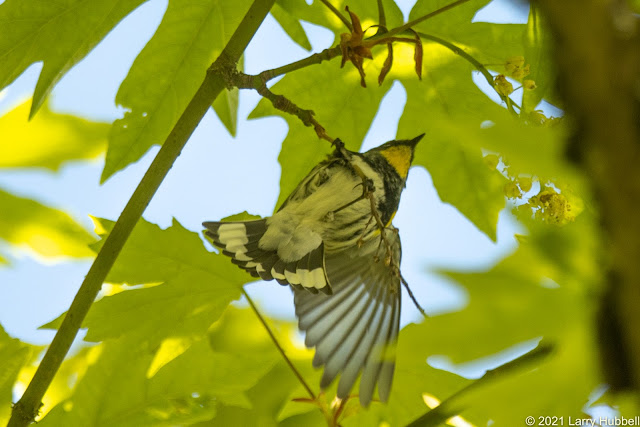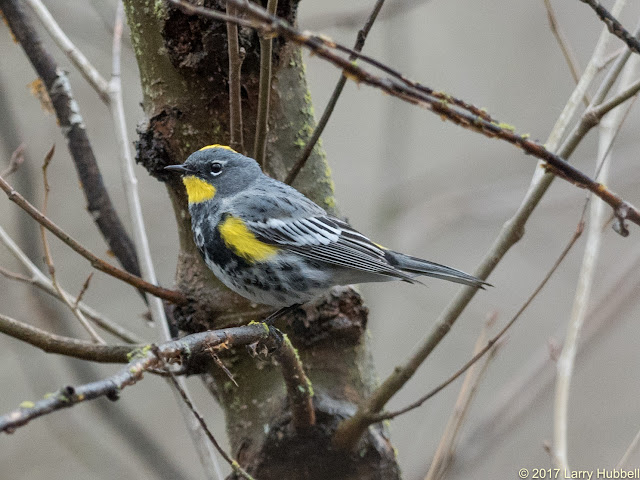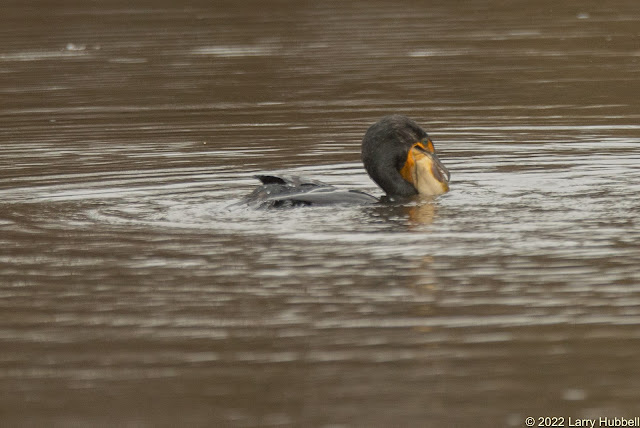Yellow-rumped Warblers are delightful little creatures. They are one of only two wintering warbler species that normally can be found around Union Bay. You can learn more about our winter warblers by clicking here. Butter Butts, is a common casual description that elicits a smile from practically everyone. The term refers to the same small yellow patch above the tail that is more formally described as a yellow rump.
For many, these sweet little warblers may bring back memories of gray days brightened by their song or sight. They almost seem to be sprinkled with sunshine. Their four (or five) yellow patches, distributed from head to bum, brighten our lives and remind us spring is coming.
They have a larger menu than most warblers. In addition to insects and seeds, they can also feed on winter fruit. Birds of the World states, "Its ability to digest the waxes in bayberries (Myrica ssp.) make it unique among Warblers and allows populations to winter as far north as Nova Scotia."
At this time of year, they commonly feed on insects. They often perch on the outer limbs of trees, where they rapidly twist and turn their heads, while choosing their next target.

When they spot a tasty prospect they leap into the air with wings aflutter. Soon they slam on the brakes - by spreading their tails and wings. In the process, they often reorient their angle of attack to snag the unlucky insect as it makes its final evasive maneuver.
It is hard to imagine that the nutrients provided equal the energy expended, but logic says it must.
Earlier, you may have noticed the comment that they can have four or five yellow patches. The variation in count occurs on the throat. In this photo, the warbler has a white throat. You might notice that the corners of the white patch extend back onto the cheek. In general, those with white throats belong to the Myrtle subspecies.
I suspect the name Myrtle is related to the fact that Yellow-rumped Warblers eat bayberries. For example, if you follow This Link and scroll down to the section "Use By Wildlife" it specifically mentions that they eat the berries of the Pacific Wax Myrtle which is in the Bayberry Family.
Those with yellow throats typically belong to the Audubon subspecies. The two subspecies also interbreed so intergrade variations are possible. Plus, there are plumage changes based on age and gender. Sorting out all the possibilities on a small quick-moving bird can be challenging. Many observers just look for the consistent yellow rump and simplify the situation by lumping them together as Butter Butts.
This week, nature surprised me with one that was even more challenging to categorize. One of the first things I noticed about this bird was the single, white-outlined, covert feather on its shoulder. I believe this indicates the bird was molting. As the new coverts grow-in, there will be more than one and they will look similar to the whitish patch on the side of the bird in the previous photo.
When we check "under the chin" we see that this bird has both white and yellow which may indicate it is an intergrade of the two subspecies.
However, the orange spot in the middle does not align with either the Myrtle or the Audubon classification.
It is also interesting to note the light brown feathers on the back that are mixed in among the white, gray, and black feathers. Brownish backs are an indicator of a first-year bird, i.e. one who hatched out last spring.

Here is an example from a few years ago of a first-year bird before its first mature molting.
Since the throat patch on this week's bird does not extend onto the cheek, the bird seems most similar to an Audubon's.
Even if we assume that the Audubon's genetics are most dominant, it does not provide any explanation for the orange spot. Where did it come from? What caused it? Is it related to something the bird ate? If so, why is the orange only under the bill and not infused in any other patches of yellow? Will it pass on this mark to its offspring? The questions are both baffling and exciting.
By the way, Butter Butts with extensive black on the sides of their chests tend to be males. Given the yellow throat, we would assume this is a male of the Audubon subspecies.
Those who are predominantly gray, and lacking the black feathers of a male, tend to be females. Given the extensive white throat patch on this bird (and the white eyebrow) this is most likely a female of the Myrtle subspecies. Looking online I did not spot any Yellow-rumped Warblers with orange on the throat. Searching my collection I did find this photo, from 2020, where the yellow throat patch has a slightly orange tint. I started to wonder if the orange coloring might have come from some other species of Warbler?
The only possibility I could find is the Blackburnian Warbler. Since we are generally on opposite sides of the Rocky Mountains I have never photographed one. Click on the following link if you would like to see a photo on All About Birds.
The Blackburnian's breeding range is in the eastern part of North America and they winter in South America. The distance between here and there might seem prohibitive. On the other hand, the breeding range of Yellow-rumped Warblers overlaps virtually all of the Blackburnian Warbler's breeding range.
My favorite range maps are the eBird annual abundance animations. Setting these two up in separate windows, and running them at exactly the same time, is challenging but fun. Click on each link to see the appropriate map:
In addition, the two species are fairly closely related. Click Here to see their relative branches on the Warbler genetic tree.
I cannot prove where the orange spot came from.
I do know that back east, Cedar Waxwings sometimes eat an invasive fruit that can turn the tips of their tails from yellow to orange. Click Here to see more. However, if a local food supply was the source of our Butter Butt's orange coloring I would suspect we would be seeing orange on a lot more birds.
My guess is a small bit of Blackburnian DNA is being passed along among some of our Yellow-rumped Warblers. If this assumption is correct maybe someday orange-throated yellow-rumps will separate themselves from our current subspecies'. Hopefully, to enable the fun of repeating it, they will be called the Blackburnian Butter Butts.
Have a great day on Union Bay...where nature lives in the city!
Larry
Recommended Citation
Hunt, P. D. and D. J. Flaspohler (2020). Yellow-rumped Warbler (Setophaga coronata), version 1.0. In Birds of the World (P. G. Rodewald, Editor). Cornell Lab of Ornithology, Ithaca, NY, USA. https://doi.org/10.2173/bow.yerwar.01
Going Native:
Each of us, who breathe the air and drink the local water, needs to watch and protect our local environment. Native plants and trees encourage the largest diversity of lifeforms because of their long intertwined history with our local environment and native creatures. I have been told that even the microbes in the soil are native to each local landscape. I hope we can inspire ourselves, our neighbors, and local businesses to respect native flora and to support native wildlife at every opportunity. I have learned that our most logical approach to native trees and plants (in order of priority) should be to:
1) Learn and leave established native flora undisturbed.
2) Remove invasive species and then wait to see if native plants begin to grow without assistance. (When native plants start on their own, then these plants or trees are likely the most appropriate flora for the habitat.)
3) Scatter seeds from nearby native plants in a similar habitat.
4) If you feel you must add a new plant then select a native plant while considering how the plant fits with the specific habitat and understanding the plant's logical place in the normal succession of native plants.
***************
New:
My friend Elaine Chuang shared several resources (that were new to me) from the January Washington Ornithological Society meeting. The major new concept is that specific keystone native plants enable critical moths and caterpillars that in turn provide food for the great majority of birds, especially during the breeding season. Here are the top two links from her list.
Native Keystone Plants for Wildlife:
https://www.youtube.com/watch?v=O5cXccWx030
Resources for adding plants to your Pacific Northwest Garden:
https://wos.org/wos-wp/wp-content/uploads/2021/12/native-plant-resources-v2.pdf
***************
Click Here to access a King County publication that explains the best placement for a wide variety of native plants. It looks quite helpful.
Also, my friend Tom Brown pointed out that the application named 'Wildflower Search' is very helpful. Click on the highlighted link to see for yourself.
Also, Jane Lundin has created a small package, with a lot of critical information that looks quite handy, and light, for backpacking in the mountains in Springtime. It is titled, Mountain Wildflowers of Washington.)
Another idea that integrates perfectly with living in harmony with nature is the concept of
Forest Gardening. Native Americans collected and nurtured dense multi-layered gardens of native herbs, plants, shrubs, and trees that produced food and herbal medicines. Even after 150 years of no maintenance, the gardens are essentially intact and the diversity of life remains significantly higher than in the surrounding forests.
Click Here to learn more.
**************
In the area below it is my intention to display at least one photo each week to help challenge us to know the difference between native and non-native lifeforms.
Is this a native tree? If so, which one?
Scroll down for the answer.
******************
Black Cottonwood: Yes, it is native. By the way, cottonwood branches are our local Bald Eagle's favorite nest-building material.
*****************
The Email Challenge:
Over the years, I have had many readers tell me that Google is no longer sending them email announcements. As of 2021, Google has discontinued the service.
In response, I have set up my own email list. With each post, I will manually send out an announcement. If you would like to be added to my personal email list please send me an email requesting to be added. Something like:
Larry, I want to see more of nature. Please add me to your personal email list.
Thank you for your patience and interest!
My email address is:
LDHubbell@comcast.net
*******************
The Comment Challenge:
Another common issue is losing your input while attempting to leave a comment on this blog. Often everything functions fine, however, sometimes people are unable to make it past the robot-detection challenge or maybe it is the lack of a Google account. I am uncertain about the precise issue. Sadly, a person can lose their comment with no recovery recourse.
Bottom Line:
If you write a long comment, please, copy it before hitting enter. Then, if the comment function fails to record your information, you can send the comment directly to me using email.
My email address is:
LDHubbell@comcast.net
Sincerely,
Larry
*******************
Final Photos:

























































